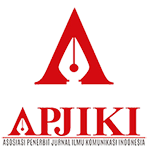LIBERICA COFFEE FARMERS GROUP COMMUNICATION PATTERN FOR SUPPORT OF SUKOREJO ECOTOURISM
Abstract
Tanjung Jabung Barat which is a peatland with the main commodity production of Liberica Coffee, the area is being developed by oil and gas companies and governments into ecotourism destinations. Ecotourism development is considered to be able to improve the walfare of the community and also maintain the conservation value of the coffee ecosystem. Liberica Coffee farmers are empowered to support ecotourism. This paper aims to describe about: (1) Interaction between Liberica Coofee farmers and their interactions with the stakeholders, (2) A one-way and two-way communication hierarchy between farmers and the stakeholders, and (3) the mapping of communication networks between liberica coffee farmers and the stakeholders. This study was conducted using qualitative methods with interviews and FGD were conducted with Liberica Coffee farmers, the company and the local government. The conclusion of this paper indicate that: (1) coffee farmers carry out intensive and long duration communication conducted at the coffee beans processing site. (2). Communication generally takes two directions so there is a tendency for farmers to take action and move together without waiting for orders, and (3) Communication is carried out by the leader of the farmer group with the stakeholders also carrried out intensively and patterned so that it can support the development of the ecotourism in Sukorejo Liberica Coffee Village in a realtively short period of time.
Keywords
Full Text:
PDFReferences
Aminah, S., Sumardjo, Lubia, D. and Susanto, D. (2014). Perubahan Model Komunikasi dan Pergeseran Paradigma Pembangunan dalam Perspektif Sejarah. Jurnal Paramita, 24 (1), 92-103. [ISSN:0854-0039]
Brc?ic?, . J., & Mihelic?, K. K. (2015). Knowledge Sharing Between Different Generations of Employees: an Example from Slovenia. Economic Research- Ekonomska Istraivanja, 28(1), 853-867
Creswell, J. W., and J. David Creswell. (2018). Research Design-Qualitative, Quantitative, Mixed Methods; 5 th Edition. Sage Publication.
DeVito, J. A. (2017). Human Communication Book - The Basic Course; 14 th edition. Pearson.
DeVito, J.. A. (2018). The Interpersonal Communication Book; 15 th edition. Pearson.
Denzin, N. K. And Lincoln, Y. S. (Ed.) (2018). Handbook of Qualitative Research. Sage Publication.
Ekasari, K., et.al. (2013). Communication Pattern and Conflict in Agricultural Extension. Asian Sociael Science, 9 (5), 27-33.
Duffy, R.. (2002). A Ttrip Too Far: Ecotourism, Politics and Exploitation. Earthscan Publications Ltd.
Fennell, D. A. (2002). Ecotourism Programme Planning. CABI Publishing.
Handaka, T. and Surokim. (2014). Pola Komunikasi Kelompok Petani Tembakau Madura sebagai Basis Penyusunan Kebijakan Pemberdayaan Ekonomi Politik. Jurnal Karsa, 23 (2), 38-48.
Littlejohn, S. W., and Karen. A. (2010). Foss. Theories of Human Communication. Waveland Press, Inc.
Mahatir, M. (2015). Pola Komunikasi Komunitas Laskar Sepeda Tua Pekanbaru Dalam Mempertahankan Solidaritas Kelompok. JOM FISIP, 2 (2),1-12.
Mihardja, Eli., B.P.L.Bintoro, D. M. Purtanti, R.Widiastuti, P. M. Agustini, and F. Adriati. (2019) Narration of Develpoment of Ecotourism in Instagram for City Branding, Study in Pinrang Regency. International Journal of Arts and Social Science, 2 (4), ISSN: 2581-7922.
Mulyandari, R. S. Hartati, Sumardjo, N. K. Pandjaitan, dan D. P. Lubis. (2010). Communication Patterns in the Development of Agricultural Human and Social Capital. Forum Penelitian Agro Ekonomi, 28 (2), 135-158.
Okwu, O. J., & Daudu, S. (2011). Extension Communication Channels Usage and Preference by Farmers in Benue State, Nigeria. Journal of Agricultural Extension and Rural Development, 3(5), 88-94.
Rupak, G. and A. Sarkar. (2009.) Interpersonal communication pattern of farmers through key communicators regarding some selected Gram Panchayat Activites. MPR Paper No. 25983, posted 23 Oct 20120 UTC, http://mpra.ub.uni-muechen.de/25983/
Saputra, A. O. (2012). Memahami Pola Komunikasi Kelompok Antar Anggota Komunitas Punk di Semarang. Jurnal The Messenger, 4(1), 25-37.
Suhartini, R. (2017). Model Komunikasi Konvergensi untuk Perubahan Sosial: Studi Interaksi Warga Kampung dan Kmapus IUNSA. Jurnal Komunikasi Islam, 07 (02), ISBN 2088-6314, DOI: http://dx.doi.org/10.15642/jki.2017.7.2.281-296.
Tesfaye, T., & Karippai, R. S. (2010). Farmers Training Effectiveness in Terms of Changes in Knowledge and Attitude: The case of Holeta, Melkassa and Debre zeit Agricultural Research Centres, Ethiopia. Journal of Agricultural Extension and Rural Development, 2(5), 89-96.
Turner, L. H. And R. West. (2017). Introducing Communication Theory: Analysis and Aplication. McGraw-Hill.
Widiastuti, T., E. Mihardja, and P. Agustini. (2019).Womens Participation on Tourism Villages Management in the Dieng Pandawa Tourism Awareness Group, 3 (1) https://doi.org/10.7454/ajce.v3i1.175
Yin, R. K. (2013). Case Study Research: Design and Methods-Applied Social Research Methods. Fifth Edition. Sage Publication.
DOI: https://doi.org/10.32509/wacana.v19i1.1009
Refbacks
- There are currently no refbacks.

This work is licensed under a Creative Commons Attribution-NonCommercial-ShareAlike 4.0 International License.
Indexed by:
Recommended Tools :
Wacana: Jurnal Ilmiah Ilmu Komunikasi
Fakultas Ilmu Komunikasi, Universitas Prof. Dr. Moestopo (Beragama)
Kampus I, Jl. Hang Lekir I/8 Jakarta Pusat, Indonesia 10270
WA: 085714422271 (Chat Only)
email: wacana@dsn.moestopo.ac.id
Copyright (c) 2025 Wacana: Jurnal Ilmiah Ilmu Komunikasi
Licensed under a Creative Commons Attribution-ShareAlike 4.0 International License.














